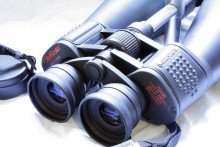With the weather being so unpredictable lately, it’s not been worth getting the scope out. This has really brought home the importance of having a ‘grab ‘n go’ option. My Celestron Skymaster 20x80s haven’t had much use lately, as I usually prefer using the telescope and/or the much lighter and more manageable 10x50s. The Celestrons were getting so little use, in fact, that I’d actually been considering putting them up for sale. Well, after a couple of sessions with them, they’re definitely staying!
The first outing was on the 2nd March. The Moon was a 4-day old crescent, plenty of ‘earthshine’ illuminating the shadow part. The binoculars (mounted on a sturdy tripod), gave incredible detail. That view alone would have guaranteed their place in my kit. However, it was the view of Venus that really clinched it. The planet looked just like a smaller version of the Moon: a slim, bright crescent. I was amazed that the phase was visible at x20, but there it was. Amazing!
The Pleiades were quite high in the west, and looked fantastic in the binoculars. I half-heartedly tried to count the stars I could see, but soon gave up and just took in the sight.
Next, I swung round to the north-west, and the constellation of Andromeda. The Andromeda galaxy (M31) itself was disappointing, largely washed out by the moonlight, but the rich orange colours of Almaak and Mirach, the former a very tight blue/orange binary, more than made up for it.
Next up was Cassiopeia, and the Owl cluster … absolutely fantastic. The outstretched ‘wings’ were very clear, and there was even a lovely rich yellow/orange colour in the brighter of the two ‘eye’ stars (34 Cas). M52, an open cluster of about 190 stars in the same constellation was a little disappointing, though, again, due to being swamped somewhat by the moonlight.
I had a quick look at the Double cluster in Perseus, but, being so high in the sky, it was a bit of a strain on the neck. Lovely, though.
The second session was a couple of nights later, with the Moon at first quarter phase … and very bright! It was also very windy.
First up was the ‘Leo triplet’. Amazingly, given how bright the Moon was, I spotted two of the three galaxies: M66 and M65, though they were little more than faint smudges, and required averted vision. Then, more in hope than expectation, I had a look for Comet 41P (Tuttle-Giacobini-Kresak), just below Leo Minor. As expected, at mag 9 and with the Moon so bright, it was never going to happen.
I turned then to Ursa Major, and managed to spot M51 and M101 (both very washed out, but amazing to see), and I also managed to split Mizar, the middle star of the handle of the Big Dipper.
The first quarter Moon, itself was absolutely incredible, with deep shadows in the craters along the terminator. I’m not a Moon person, but that view, with these binoculars, was stunning! Patches of cloud blowing through the field of view and across the moon made for a very dizzying effect!
Above and to the right of the Moon was the constellation of Auriga (the charioteer). I was easily able to make out the three open clusters there: M36, 37 and 38. They were a little washed out, but I was able to resolve several individual stars.
A glance at Betelgeuse and then Aldebaran and the Hyades, just to take in the lovely reddish/orange colour in the two named stars, and then I took another look at the Pleiades. This time I actually counted 45 stars before giving up.
All the objects I looked at would have appeared much clearer and brighter under dark skies, of course, and I can’t wait to revisit them when the Moon’s not around. ‘Both-eye’ viewing is, obviously, different to ‘single-eye’ viewing, in that the three-dimensionality of the view is more apparent, and it’s also more relaxing to have both eyes open.
I’d have no problem recommending these to anyone with an interest in stargazing (the fact that they’re currently available for as little as £79* makes them a no brainer).
*Other binoculars are available, mileage may vary, and you’d definitely have to budget for a tripod!
What’s up?
With the Moon lighting up the evening sky throughout the month (full on the 11th, last quarter on the 19th) there’ll be little to observe until the New Moon on the 26th (brighter stars, some colourful binaries, plus Venus, Jupiter and the Pleiades being the exceptions).
However, something to bear in mind is Comet 41P (Tuttle-Giacobini-Kresak). Currently around mag 9, this will brighten throughout March as it moves through Leo Minor and into Ursa Major. Definitely worth looking out for around the New Moon. It may even be bright enough to see with the naked eye!
Clear skies!
Kevin Quinn is an amateur astronomer living in Piddletrenthide. He is the proud owner of a ten-inch reflector, a small refractor, a case of eyepieces, and a couple of pairs of binoculars. He tweets via @CerneAstro, and blogs (occasionally) via theastroguy.wordpress.com.
©Kevin Quinn







